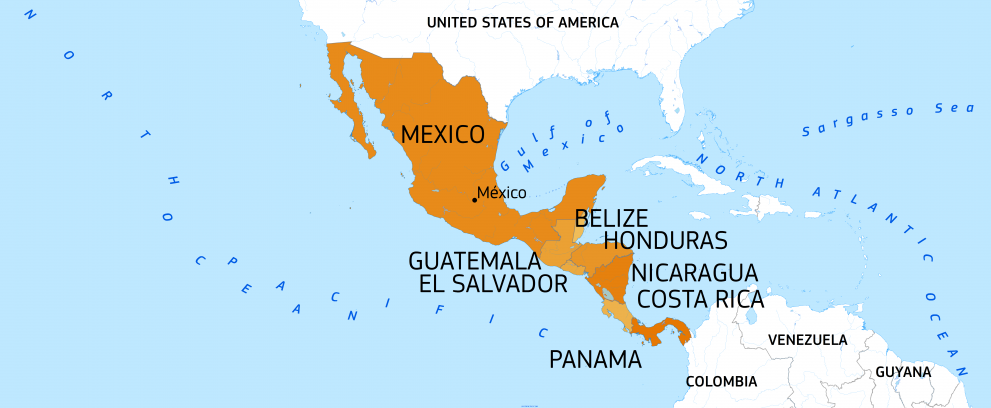Introduction
In Central America and Mexico, natural hazards, violence, and displacement have all exacerbated the ongoing humanitarian crisis. The United Nations estimates that about a quarter of the region’s population requires humanitarian aid – an 80% rise from 2020.
In 2023, more than 520,000 crossed the hostile jungle of the Darien Gap, bordering Colombia, and Panama. It is one of the most dangerous transit routes in the world, where people on the move face a myriad of perils, including robbery, sexual assault, and physical violence.
What are the needs?
According to the United Nations, millions of people across the region endure food insecurity and malnutrition, with steadily decreasing coping capacities further exacerbated by El Niño. This includes 5.3 million people in Guatemala, 2.8 million in Honduras and 1.1 million in El Salvador, all of whom are in need of humanitarian assistance.
Widespread extreme violence has triggered humanitarian and protection needs that are equivalent to warzones. The consequences include (forced displacement, movement restrictions or confinement, sexual and gender-based violence, forced recruitment, including of children, extortion and rising barriers to accessing essential services and livelihoods.
Vulnerable people require humanitarian aid for basic necessities such as food, shelter, healthcare, education and protection. Asylum seekers often face limited access to services and employment, are exposed to xenophobia and discrimination, and require legal assistance.
In El Salvador and Honduras, a state of emergency impacts the humanitarian access to vulnerable communities. It often affects children, who become head of households.
In Nicaragua, government repression continues to reduce the humanitarian space. Over 741,000 Nicaraguans have left the country between 2018-2022, surpassing the Cold War era. Most of them fled to Costa Rica, now the world’s third largest recipient of new individual asylum applications.

How are we helping?
Since 1994, the EU has provided €354.5 million in humanitarian aid and disaster preparedness to Central America and Mexico.
In 2023, the EU allocated €23 million to the region, including €1.3 million released to respond to the impact of hurricane Otis in Mexico.
In 2024, the EU is funding €18 million to Central America and Mexico. An additional €1.5 million will be allocated to a regional response to the Dengue outbreak in South and Central America.
EU humanitarian funding supports projects providing health services and protection to displaced people across Central America, as well as to children and families affected by violence in Mexico, Guatemala, Honduras, El Salvador, and Nicaragua. We also provide support to the victims of Nicaragua’s civil unrest beyond the country.
EU funding has also helped respond to emergencies such as floods, droughts, hurricanes, epidemics, earthquakes and volcanic eruptions. In addition, it has also meant vulnerable communities can build resilience in the face of potential future disaster.
A Memorandum of Understanding on disaster risk management has been established as a new collaboration instrument between the European Union and the Latin America and Caribbean region. This agreement focuses on disaster preparedness and risk management, and it became effective in May 2024. Many regional disaster management agencies, including the Coordination Centre for the Prevention of Natural Disasters in Central America (CEPREDENAC), have signed as parties to the agreement.
Since 1994, the EU has allocated over €100 million to strengthen disaster preparedness, an integral part of EU-funded humanitarian projects.
An improved, timely response to disasters requires targeted actions assisting local communities and institutions. This enables them to identify risks and mitigation measures both before and during natural disasters, including:
- people-centred Early Warning Systems in critical river basins in Guatemala and Honduras,
- Improve climate and environmental resilience,
- anticipatory action to address drought and food insecurity in Central America,
- strengthen capacities and coordination of civil society that provide humanitarian assistance to people on the move,
- improve coordination and preparedness to forced displacement.
The EU’s satellite system COPERNICUS was activated yearly since 2020 to provide free imagery in support of disaster response to floods in the northern Caribbean Coast of Nicaragua and wildfires in the Mexican states of Nuevo Leon and Tamaulipas, as well as hurricane Otis in Acapulco.
The EU Civil Protection Mechanism was activated after the COVID-19 outbreak to address needs for medical supplies, including vaccinations and equipment in El Salvador, Guatemala, and Honduras. It also coordinated repatriation flights of EU citizens stranded in the region.
Last updated: 15/05/2024
Facts & figures
More than 1 million internally displaced persons. (Internal Displacement Monitoring Centre)
Over 636,000 refugees and asylum seekers from Northern Central America worldwide. (UNHCR)
More than 10 million people need of assistance in the dry corridor of Central America (Guatemala, Honduras, El Salvador and Nicaragua). (WFP, OCHA)
More than 520,000 people have crossed the Darien gap between Panama and Colombia to continue their journey through Central America in 2023. (Panama Government, MSF)
EU humanitarian funding:
€108.5 million for 2020-2024
€354.5 million since 1994

